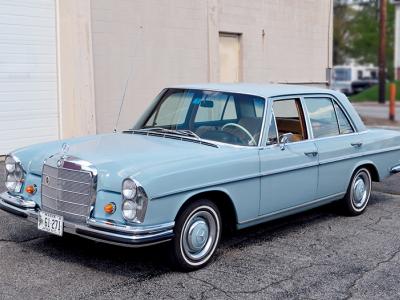 Does your heart desire an affordable, practical performance model from the glorious past of Mercedes-Benz? If so, we are pleased to present you with a plethora of purchasable possibilities!
Does your heart desire an affordable, practical performance model from the glorious past of Mercedes-Benz? If so, we are pleased to present you with a plethora of purchasable possibilities!
Buyers Guide:
MIND YOUR Ps & Qs
Performance-satisfying alternatives to legendary Mercedes-Benz Q-Cars
Article Pierre Hedary
Images Daimler Archives and Bill Welsch
Often the pursuit of the classic Mercedes high-performance “Q-car” – the term taken from the British Q-ships used in both World Wars that looked like freighters but were capable of high-speed pursuit – can bankrupt its owner in the task of sorting. The continuous needs of these cars limit their enjoyment and the bonding experience between car and driver. Such Q-cars include the various legends of Mercedes lore: the 600, the 300SEL 6.3, the 450SEL 6.9, the 500E and the 190E 16-valve. As great as these cars are, maintaining them is the equivalent of raising a child.
However, for many of these sophisticated Q-cars, a less complex but still potent “P” car exists in the shadows. Think of the P as standing for “practical performance.” Does your heart desire an affordable, practical performance model from the glorious past of Mercedes-Benz? If so, we are pleased to present you with a plethora of purchasable possibilities!
Right between the 600 and a 300SL
Many of us daydream about what it would be like to own a 600, or a 300SL. While the 600 is now a six-figure car, and the 300SL fetches seven-figures, there is a third model that meets them in the middle.
In 1966, the 108 series entered full production. The M189 6-cylinder engine was updated for use in the model line, and a discreet sports sedan, the 300SE (W108.015) entered production. The 300SE was blessed with the performance of the 600, all of the rarity, and an amazing mechanical pedigree, sparing the comfort hydraulics and air suspension of the 600. If the desire for the air suspension is still present, but not the voracious neediness of the M100 engine, then one may also consider the 300SEL.
I know that some of you might be laughing at this comparison, but you are the reader for whom I’m writing this article. The 600 had a top speed of 120 mph, 0-60 times of 10 seconds, and the fuel economy of your grandfather’s Winnebago. The 300SL had a beautiful inline-six engine with 215 horsepower, but to get the mechanical package, you must buy the body with it.
The 300SE marries the 600’s rarity, craftsmanship and performance with the 300SL’s mechanical pedigree. Good examples cost around $19,000. While some might to be concerned with the M189 engine, it is actually a very robust mechanical package. The $25,000 or so for an engine rebuild is still cheaper than sorting out the best 600, and is less than the buyer’s fee on any 300SL. After driving examples of the SL, the 600 and the 300SE, I can tell you that the 300SE holds its own against the two, being faster than a 600, and noticeably reminiscent of the W198’s mechanical harmonies.

1966 W108 300SE
I just passed your 6.3, and not at a gas station!
I can picture their faces now – all of those dedicated 6.3 owners. How dare someone suggest that there is a more pleasurable car to own, with nearly as much power and prestige?
At home in the Mercedes-Benz Club of America, we love the 6.3 – it is a successful model of oppositional defiance that sparked a trend. However, for potential buyers who wish for a classic Mercedes of the W108-W109 parentage, and wants the performance to match but cannot foot the cost of maintaining a 6.3, there is hope! In spring of 1971, the 4.5-liter engine found its way into the 280SE. The marriage of body and engine was the highlight for 1972. The 4.5 is just as much fun to drive, just as responsive when pushed and much easier to sort out than a 6.3. The 4.5 has just one handicap that, literally, slows it down.
The 4.5 was equipped with, and let down by, a very smooth and sedate 3-speed automatic that shifted nicely and lasted for hundreds of thousands of miles. If Mercedes had planted such a gearbox in the 6.3, I am sure it would have lost its bottom-end mojo as well. When I rebuilt my 4.5, I outfitted it with the 4-speed gearbox from a 300SEL 3.5; the car was transformed. Off the line, it is just as much of a rampant tire-burner as a 6.3, with none of the air-suspension issues, cramped working conditions and sore driveline components. Even with its factory 3-speed box, the 4.5 is more than fast enough to pass most cars effortlessly and get you into trouble.
A good 4.5 will usually need many of the things a 6.3 does, but the coil-spring suspension and sturdy mechanicals equate to significant cost savings. The 4.5 also gets 15 mpg. For any additional information on the 4-speed automatic installation, feel free to email me.
1971 W108 280SE
All of the fun of a 6.9, with more refinement
The 450SEL 6.9 graced the U.S. market from 1977 to 1980. With its lovely but detuned engine, its nimble but complex suspension and its below-par automatic climate-control system, much of the hype surrounding the 6.9 might be tied to its displacement.
There are two possible divergent alternatives available. The first was within the W116 fold. The early 350SE built for the European market was not a 6.9 by any stretch, but it was available with the high-revving M116 engine and a 4-speed manual gearbox. The 350 is a very rare car, but some of the perks from this platform can be more easily acquired in the form of a 450SE or SEL. Early versions of these cars are good for 130 mph, and 0-60 times of under 10 seconds. At road speed, only the selective leveling of the 6.9 will be missed.
Mercedes actually refined all of these ideas for the European market when the W126 was launched. In 1980, the 500SEL replaced the 6.9. It had a nicer climate-control system, and a very usable 234 horsepower. In Europe, the 500SEL was available with the 4-wheel hydraulic suspension, and its other features were drastically refined. With a rating of 15-17 mpg, the 500SEL lost some performance to the 6.9, but its other strengths made the horsepower deficit less of an issue.
In 1986, Mercedes launched a hot version of the 560SEL. A 560 with 4-wheel hydraulic suspension and 300 horsepower is quite a treat. These cars have not been discovered by those who lust after the 6.9, which effectively makes a Euro W126 with 4-wheel hydraulic suspension a bargain. Compared with any W116, the W126 is such a refined product that you may never want a 6.9 after driving a good 500SEL.

1986 W126 560SEL
If you remove the badge; no one will know!
The 500E was launched amid a wave of publicity. The V-8 engine was a natural in the W124, but years after 500E production ended, good examples became rare and expensive. However, the same M119 4-cam V-8 that lived under the hood of the 500E was also crammed under the hood of the 400E. The 400E is half the price of a good 500E now, and the powerful 4.2-liter version of the M119 engine leaves you plenty of usable power.
Production of the 400E was much higher, leading to a greater number of available well-kept cars. The actual difference is about 40 horsepower, and the 400E has a taller final drive, leading to exceptional fuel economy for a V-8 sedan. Some might miss the hydraulic rear suspension, bespoke seats and Porsche touches of the 500E, but for those of us who want a usable V-8 W124 sedan – and some money left over to buy gasoline – the choice is obvious.

1993 W124 400E/E420
Six is always smoother than four
The Mercedes 190E 2.3-16V is the stuff of legend. With its Cosworth-designed head, 5-speed transmission and stiff suspension, there was nothing else like it. Unfortunately, the 16-valve came with a needy valve train and many more service nuances. Good 16-valves are difficult to find, with many being used as track rats, and treasured cars come with some strong prices.
So what does that leave us with? In 1988, Mercedes introduced the 190E 2.6. This model was available for its entire production run with an optional 5-speed manual. The M103 engine produced 155 horsepower, which was only 12 units less than the U.S.-market 16-valve model. This engine revved high, was fuel-efficient and was very easy to service. The best part of it was that the 2.6 could also be found with a number of updates the earlier W201 never received, making them visually just as attractive as the spoiler set on the little 4-cylinder hot rod.
For the driver, many subtle upgrades, such as heavy-duty Bilstein shocks, stiff springs, thicker sway bars and better braking were a bolt-on affair. This leaves the 2.6 manual as a desirable and competitive option against the Cossie. And the best part? Again, a good 2.6 is always half the price! The only caveat is the difficulty in finding one!

1988 W201 190E 2.6
Summing up
So when you catch yourself daydreaming about that Mercedes Q-car, remember that the engineers at Daimler-Benz were thinking of those who might prefer a less complicated performance package. In the case of these almost-Q-cars, less truly does equal more when you consider how much money you can save and how much car you will have as a result. In the meantime, I will be hunting for 6.3s in my 280SE 4.5!
Technical Specifications: 1965-1993 Q-Car Alternatives
Model Years Production Engine HP Torque Trans 0-62 Top Spd MPG [US]
W108 300SE 1965-1967 2,737 2996cc I-6 195 203 4-A/4-M 12 sec 120 12-14
W108 280SE 4.5 1971-1972 13,527 4520cc V-8 230 279 3-A 9.5 sec 118 12-15
W126 500SEL 1979-1991 33,418 4973cc V-8 184 247 4-A 7.7 sec 140 12-17
W126 560SEL 1985-1992 30,089 5547cc V-8 238 287 4-A 7.2 sec 140 11-16
W124 400E/E420 1991-1993 31,597 4196cc V-8 275 295 4-A 7.1 sec 149 16-21
W210 190E 2.6 1986-1993 70,987 2599cc I-6 158 162 4-A/5-M 8.2 sec 133 23-25
Value Guide
Model Year Low Medium High
W108 300SE 1965-1967 $ 8,500 $19,600 $24,800
W108 280SE 4.5 1971-1972 $ 8,500 $18,900 $25,000
W126 500SEL 1979-1991 $ 3,200 $ 6,400 $ 9,000
W126 560SEL 1985-1992 $ 3,800 $ 6,900 $ 9,200
W124 400E/E420 1991-1993 $ 3,900 $ 7,600 $ 9,300
W210 190E 2.6 1986-1993 $ 2,500 $ 5,000 $ 7,200
Add to Values: +10% for sunroof; +10% for floor shifter
